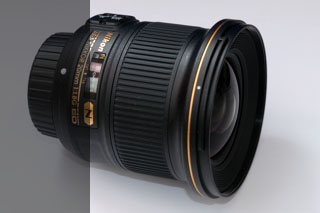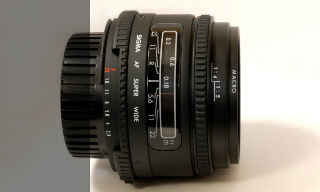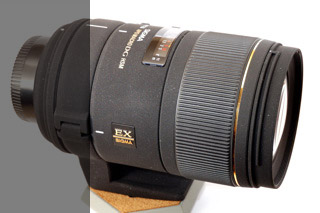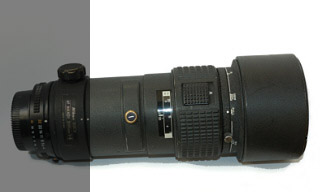AF fix focal
Nikon and Sigma auto focus fix-focal lenses

Nikon AF-S 20mm 1.8 ED – pelimenary review shortly after lens availability
Thirty years ago Nikon introduced the last 20mm fix focal lens design, the 20mm 2,8. The optical formula remained unchanged during the transformation into an autofocus lens in 1989 and also the change to AF-D left the optic untouched.
Nikon started to update the fix focal lens range a few years ago. Like in the past different lenses at different pricings were introduced. 35mm, 50/58mm and 85mm are offered in a f/1,8 and more expensive, gold ringed f/1,4 variants. From 28mm on downwards Nikon changed the approach and offers only gold-ring lenses, whereas the 24mm 1,4 plays the role of the more luxurious model at high speed, where 28mm 1,8 and the new 20mm 1,8 offer a modestly priced alternative.
Despite the fact that wide angle lenses made impressive progress during the last ten years and top products like the 14-24mm 2,8 leave little to be desired, many people are still longing for smaller, lighter and brighter fix focal alternatives. Nikon has just delivered this alternative in the form of the new 20mm 1,8 lens and surprisingly the price is relatively modest.
The above already mentioned 14-24mm 2,8 makes it relatively hard for any other lens to compete. Unless weight is a deciding factor, optical performance is excellent and the price of approx. 1600 € makes it hard to introduce another excellent lens design below that – excellent lenses usually come at a higher price. A price of 800 € for a 20mm lens at the high speed of f/1,8 makes you wonder how good the performance can be. To break the news early on: the lens is way better than the price indicates.
For sure weight and size will be one main factor to buy this lens. While the 14-24mm 2,8 weight approx. 1kg, the 20mm 1,8 is much more suited for airline trips with limited carry-on luggage: 355g is more than the predecessor (270g), but you gain more than a stop wide open. Build quality is decent and in line with the recent f/1,8 lenses. Actually it is pretty hard to differentiate the 20mm 1,8 from the 28mm 1,8 when both stick in the photo bag. The 20mm is a little bit bigger in diameter.
Wide open performance of f/1,8 will be the other criteria for many people. So, how does it perform overall? Right from wide open the lens delivers a very good sharpness. At the edges and in the corners sharpness drops gradually, but the resolution is still on a very usable level. No comparison to older wide-angle lenses. Stopped down to f/2,8 edged are already excellent, corners become good. Latest at f/4 sharpness is perfect across the frame.
Vignetting can be seen between wide open and f/2,8 (gone by f/4), however it is much less problematic as with the 28mm 1,8. Contrast is a little bit reduced in daylight scenes up to f/2,8. In a dim environment there is little difference in this regard between wide open and f/2,8. Shooting into the sun is a pleasure, especially compared to the 14-24mm 2,8. The tendency for flare is very, very low. Distortion is moderate and has only a slight mustache character. It should be easy to correct.
Compared to the 14-24mm this lens delivers a better edge and corner performance at f/2,8 and even comparing apples to oranges (f/1,8 on the 20mm and f/2,8 on the 14-24mm 2,8 at 20mm) I would give the edge to the 20mm lens. At f/4 both lenses are equal.
Overall the lens is a very impressive performer. If you can live with a single 20mm lens as your wide option, don’t look any further. If you need the flexibility of a wide zoom and/or a lens wider than 20mm, this lens is a perfect companion for low light scenes or when you need to travel light.
Samples (FX / 36MP): 20mm f1,8 20mm f1,8 20mm f1,8 20mm f2,8 20mm f2,8 20mm f2,8 20mm f4,0 20mm f1,8 (background blur) 20mm f8 directed towards the sun
Samples (DX / 12MP): 20mm f1,8 20mm f1,8 20mm f2,8 20mm f5,6 20mm f1,8 20mm f2,8 20mm f4,0

Sigma AF 24mm 2.8 Super Wide II
A very compact lens which feels solid when you hold it for the first time. This impression disappears quickly when you engage autofocus for the first time. It rattles like a baby doll, mechanical AF grinding at it’s best. Other than that the lens feels quite nice due to it’s metal construction and rubber coating on the lens barrel.
The optical performance is a mixed bag. The lens is quite soft at f/2.8, improves moderately at f/4.0 to become sharp at f/5.6. The Sigma is sharper than the 24mm 2.8 AI Nikkor but the Tamron 17-50mm 2.8 at 24mm beats it at every aperture. The color is very cool compared to the 24mm 2.8 AI or the Tamron. Overall performance is better than the AF 24mm Nikkor I had, contrast is low on wider apertures, overall the lens is good from f/5.6 on.
Older Sigma lenses often suffer from incompatibilities with newer Nikon bodies and this lens seems to have problems, too. On a D70s the lens reports f/3 as the maximum aperture, on the D200 it reports f/2,8. On the D200 f/4 overexposes by EV +0.7, on the D70s only by +0.3, other apertures are OK. The aperture of my sample may be a bit sticky leading to the overexposure problem at f/4.
Sample (DX / 10MP): 24mm f5,6
Sample (FX / 36MP): 24mm f5,6

AF 35mm 2.0
Compact lens, mimics the “normal” lens on DX digital due to the crop factor. Usable at f/2.0, but not stellar even on lower resolution bodies. Stopped down the performance gets better, but overall I prefer a professional zoom like 35-70mm 2,8, 28-70mm 2,8 and 24-70mm 2,8 compared to this lens. Some of the early 35mm AF-D lenses had a problem with oil leakage. The oil from the focusing gear dripped on the aperture blades and the blades got stuck. Check the lens careful when buying used.

AF-D 50mm 1.8
Perhaps the most cheapish looking lens in Nikons line-up, doomed with a “Chinese-feeling” and very light. The most affordable lens Nikon has to offer, it can be found for around 130 Euro new. I always wonder when Nikon will drop the metal mount due to cost cutting and replace it with the plastic bayonet that is becoming more popular for consumer lenses in the marketing and controlling department nowadays. Performance is not very good wide open, stop down to f/2.8. Optically as good as it gets by f/4.0. Supposedly better by f/5.6 compared to the more expensive 50mm 1.4.

AF 85mm 1.8
Great “sniper” lens for parties, head portraits are possible from greater distance without having the people realize that there is someone about to take a picture. Great by f/2.2, usable wide open. A real classic, should be in every photographers bag. If you can afford the big price difference, go for the 1.4-version which is known to be even better, for the average shooter the 1.8 version is all they ever need.
Sample (DX / 10 MP: 85mm f5,6
Samples (FX / 36 MP): 85mm f/1,8 85mm f/2,8

Sigma 150mm 2,8 Macro HSM
Most if not all macro lenses on the market today offer a very good optical performance and you don’t have to worry about this aspect when you intend to buy a macro lens. The choice lies in the desired features and the purpose of the lens. If you like to shoot static subjects with a good possibility to set up lights you can do with a 50 or 60mm macro. If you want to shoot flowers or insects you need a larger minimal focus distance – and here macros of 100mm to 200mm come into play. The recent inclusion of vibration reduction in some macro lenses accommodates free-hand shooters.
The here reviewed version of the Sigma 150mm Macro is the still current, but at the same time old version of the lens without VR. At the time of writing Sigma already announced a newer version which includes their vibration reduction system OS.
Like I already wrote above: All real macro lenses from any manufacturer of fame are very, very good in their domain, which is shooting closeups at apertures of f/8 to f/16. This lens is no exception, but there is more. The longer focal length of 150mm has not only the advantage of a longer working distance, but also make the lens attractive as a bright medium tele.
The Sigma 150mm covers all aspects that you associate with a lens of this focal length and maximum aperture with great success. The lens is amazingly sharp wide open in the cener with just a slight drop-off at the borders on FX, has an acceptable bokeh and a pleasant overall rendering. Only on FX vignetting is an issue. You have to stop down to f/5,6 or f/8 to bring it down to an low level.
Built quality is very good like all other Sigma lenses from the superior EX series. With almost 900g it feels substancial and a detachable tripod mount is completing the package. The HSM focus is very silent, but on the slow side. Given the fact that this is a macro lens this is no surprise and the focus limiter comes to resuce by cutting the focus travel distance in half. In dim situations unfortunately the focus starts to hunt.
All in all a perfect macro lens and a good fast tele on both DX and FX.
Samples (DX): f2,8 f2,8 (effective 3,2) f2,8 (3,5 effective) f2,8 (4,2 effective) f8,0 f11,0
Samples (FX): D700/12 MP: f11 D800/36MP: f3,2 f11

AF 300mm 4.0
The smaller brother of the Nikkor 300mm 2,8 is built like a tank, offers a tripod mount, focus limiter and an integrated sunshade.
The optical performance is on a very high level. At f/4 it is already acceptable, picking up in sharpness at f/5 and staying on a very high level from then on. It works very well with teleconverters.
